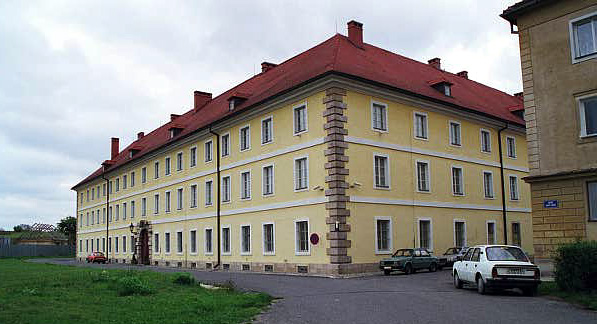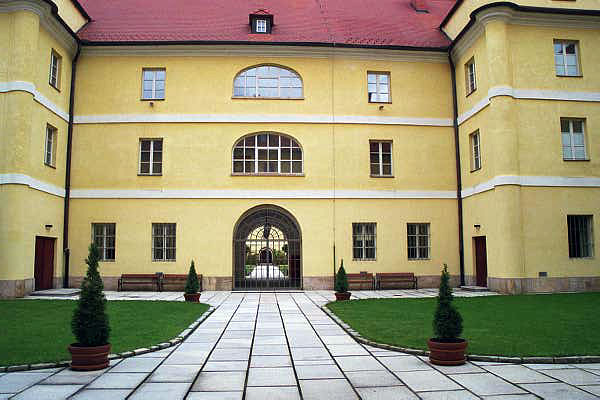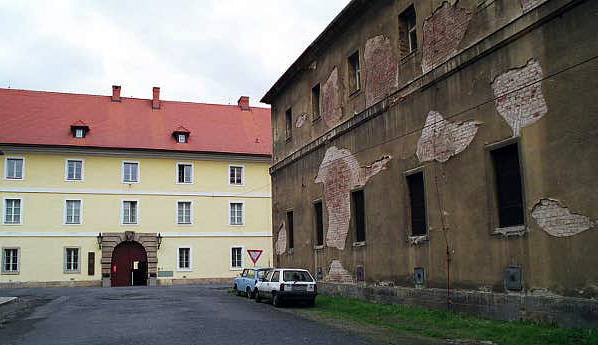Art Museum in Terezin
 Rear view of the Art
Museum in the former Magdeburg barracks
Rear view of the Art
Museum in the former Magdeburg barracks
The photograph above shows the rear view
of the Magdeburg barracks, which is now the second Museum in
Terezin; it is devoted to the artwork produced by the inmates
in the ghetto. This same building was formerly used to house
women prisoners when Theresienstadt was a ghetto and a transit
camp for the Jews.
The building extends from one end of
the block to the other and has a series of three interior courtyards,
one of which is shown in the photograph below. The Dresden barracks
for women has an identical courtyard, but the Dresden building
is not open to tourists. The prisoners played soccer in the courtyard
shown below.

Magdeburg barrack building
has three inner courtyards
The Magdeburg building was also used
to house the offices of the Jewish "self government"
during the ghetto days.
The Art Museum at Terezin, which is located
in the former Magdeburg barracks, is devoted to the artwork produced
in the Theresienstadt ghetto. Before World War II, the German
people were considered to be the most cultured in the world.
Art and music had such importance for them that they allowed
cultural events in even the worst of the concentration camps,
and encouraged the prisoners to create art and music in what
little free time they had.
Every concentration camp had its orchestra,
made up of inmate musicians, and concerts were staged even in
the worst camp of all, the one at Birkenau, the Auschwitz II
camp. Typically, the camp orchestra would play classical music
as the prisoners marched off to the factories to work and even
as they marched to their deaths in the gas chamber. During the
week of cultural events in June 1944, on the occassion of the
Red Cross visit, there were performances of Brundibar in the
Magdeburg building.
The prisoners were allowed to do art
work in the concentration camps, although not what Hitler called
"degenerate" art. Hitler favored classic art or beautiful
pictures, as opposed to modern art or realistic drawings depicting
the horrors of the camps. The prisoners had to hide their drawings
and paintings that the Nazis didn't approve of, but they had
the courage to produce this art, even with the threat of death
if they were found out.
In 1944, the Nazis discovered some of
the "degenerate" artwork illicitly done in the camp,
and sent the artists and their families to the Gestapo prison
in the Small Fortress across the river from the ghetto. Only
one of them survived the harsh conditions in the Small Fortress.
Although several of the Nazi concentration
camps, such as Majdanek, Buchenwald and Auschwitz, had artists
who sketched, painted or sculpted, leaving works of art which
are now displayed in the museums there, the Theresienstadt ghetto
was unique for the sheer volume of artwork that the prisoners
produced during the war. Taking advantage of the many famous
artists who were incarcerated in Theresienstadt, the Nazis set
up a drafting workshop in the ghetto where the Jews had to use
their talents to produce blueprints for the Germans. The Jewish
artists in the Theresienstadt ghetto were also commissioned to
do paintings for the SS headquarters.
The photograph below shows the intersection
of Hauptstrasse and Jägergasse with the front entrance to
the Magdeburg barracks on Hauptstrasse and the former Hannover
Barracks on Jägergasse. All the barracks buildings were
named after cities. The Hannover barracks, which was allowed
to fall into ruin since the end of the Nazi era, was used during
World War II to house male Jewish prisoners.

Front entrance to Magdeburg
Museum on left, Hannover barracks on the right
After the war, some of the perpetrators
of the genocide of the Jews eluded justice, but most of them
were caught, brought to trial and swiftly executed. Two of the
Commandants of Theresienstadt, Karl Rahm and Siegfried Seidl,
were executed after being convicted in courts in Litomerice and
Vienna.
Karl Rahm was the last Commandant, serving
from February 8, 1944 to May 5, 1945 when he handed the camp
over to the Red Cross before he escaped. He was captured in Austria
and charged with crimes against humanity for his part in sending
the Jews to their deaths in Auschwitz.
The second Commandant, Anton Burger,
and the camp inspector, Karl Bergel, managed to escape from justice,
although they were both tried in absentia and condemned
to death. From 1945 to 1948, the Small Fortress was used as a
prison where German war criminals awaited trial and subsequent
execution for their crimes against humanity.
|